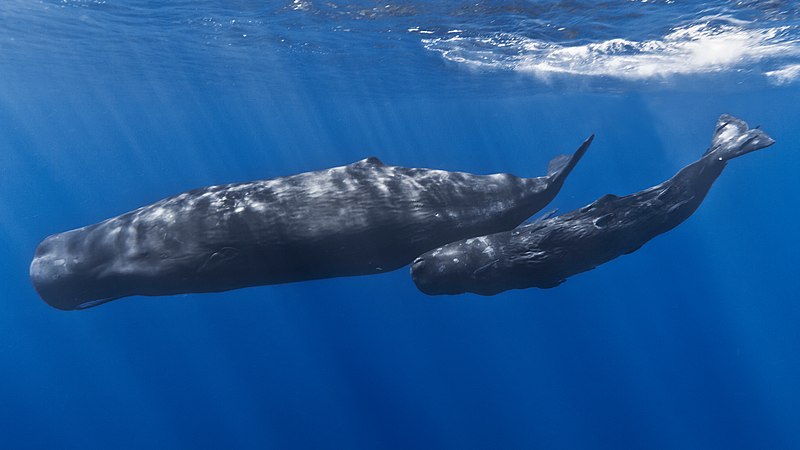The sperm whale, or,
Physeter macrocephalus, is the largest of the toothed whales. They get their name from the oily fat which is called spermaceti that is contained in their very large heads. They are able to stay underwater for up to two hours before coming up for air. They can grow up to a length of 67 feet and weigh over 63 tons. The males are generally 30-50% bigger than the females making them one of the most sexually dimorphic of all the whale species.
 |
Sperm whale mother and baby
http://en.wikipedia.org/wiki/File:Mother_and_baby_sperm_whale.jpg |
They use ecolocation to find their food which is beneficial because sperm whales dive very deep to find their food. They love to eat giant squid and colossal squid but no direct observance has been seen of their battles. They can dive as deep as 10,000 feet but they typically stay at about 2,600 feet. They are very social animals and live in groups. Their have a naturally enemy in the killer whale and only the oldest and larges sperm whales are immune to their attacks. It is believed that sperm whales live to be about 70 years old. They were once widely hunted for their oils but now they are listed as a vulnerable species and only Japan and Indonesia still hunt them. They hunt for the giant squid on the continental shelves where they can dive very deep to hunt for them. They are found in all oceans all over the world. The population of sperm whales in the South Pacific is divided into five vocal clans. The clans had different movement patterns and that depended on how well they did during a particular year. The clans were affected differently by food availability as well as global warming effects. The different 'cultures' of the whales affect their ability to adapt and survive.
Sources
http://www.seasky.org/deep-sea/sperm-whale.html
Griffin, Robert B., Sperm whale distributions and community ecology assiciated with a warm-core ring off Georges Bank
Marine Mammal Science (1999)
15(1) 33-51 (http://onlinelibrary.wiley.com/doi/10.1111/j.1748-7692.1999.tb00780.x/pdf)
Mathias, Delphine, and Aaron M. Thode, Acoustic and diving behavior of sperm whales (
Physeter macrocephalus) during natural and depredation foraging in the Gulf of Alaska.
Journal of the Acoustical Society of America (2012) 518-532. ( [http://dx.doi.org/10.1121/1.4726005])
Whitehead, Hal, and Luke Rendell, Movements, habitat use and feeding success of cultural clans of South Pacific sperm whales.
Journal of Animal Ecology. (2004)
73 190-196. (http://journals.ohiolink.edu/ejc/pdf.cgi/Whitehead_Hal.pdf?issn=00218790&issue=v73i0001&article=190_mhuafscospsw)

No comments:
Post a Comment
Note: Only a member of this blog may post a comment.